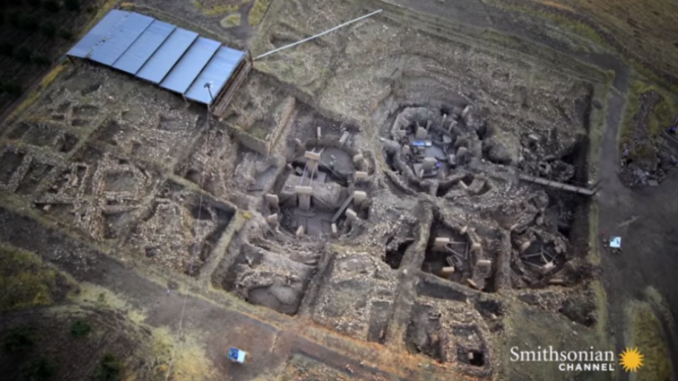
Several miles east by northeast of the ancient city of Urfa (now Şanlıurfa) in southeast Turkey, not far from the Syrian border, lies a prehistoric archaeological site that is thousands of years older than written language, pottery, metallurgy, Stonehenge, and the wheel. It even predates agriculture, a fact that turns our understanding of pre-history on its head.
For decades, archaeologists, anthropologists, and other scholars held the notion that agriculture gave rise to complex social structures. Prior to agriculture, they believed, hunter-gatherers didn’t have the luxury of spare time and the wealth of food and other resources to organize into complex societies. Göbekli Tepe is proof that complex societies existed before agriculture, and actually gave rise to farming rather than the other way around. The site is at the top, northern edge, of the Fertile Crescent, where agriculture first appeared, in the same region that Tel Abu Hureyra, Tell Barri, Tell Brak, and other ancient cities are located.
‘Göbekli Tepe’ is a Turkish phrase which has been variously translated as ‘belly hill’, or ‘hill of the navel’. When discovered by archaeologists, it was literally a roundish man-made hill (a tell, or tel) 15 m (50 ft) high, with a diameter of 300 meters (1,000 feet). It sits on the crest of a mountain ridge, 760 meters ( 2,500 feet) above sea level and 300 meters (1,000 feet) above the valley it overlooks. The entire complex is approximately 22 acres.
Archaeologists from the University of Chicago and Istanbul University first investigated the site in 1963, but incorrectly assumed it to be little more than a Byzantine cemetery. In 1994, German archaeologist Klaus Schmidt, a member of the German Archaeological Institute, was investigating other sites in the area and decided to visit Göbekli Tepe himself. He immediately recognized there was something more to this than just a medieval cemetery. The following year he began a dig which uncovered a religious site more important than Stonehenge. The culture that built Göbekli Tepe carved giant pillars out of nearby limestone deposits, moved them several hundred yards, and inserted them upright into sockets cut into bedrock. Each pillar weighs an estimated 10 tons, with a height of 6 meters (20 ft). The pillars were arranged in circles or rings, with dozens of rings located at the site. No evidence of habitation has been found, meaning this was built for ceremonial purpose only. Many animal bones have been found, but few human bones. For unknown reasons, the rings were later filled in with dirt, the pillars buried. For what purpose or motivation, no one knows. This neolithic project was a gigantic undertaking that required a great deal of manpower and years to accomplish. It demonstrates organization and purpose, two things that were presumed beyond the abilities of stone age cultures.
What all this means is, hunter-gatherers did have the spare time and a wealth of food and other resources to organize into a complex society, before agricultural. This discovery has lead to the new theory that complex social structures were created first, and led to agriculture.
“This Mysterious Stone Structure Is Older Than Stonehenge” (4:20):
Question of the Night: You’ve been transported back in time 10,000 years. Will you be a hunter-gatherer, or one of the first farmers?
